The Arts Alliance is warning that budget cuts and payment-by-results contracts in the criminal justice system could put some rehabilitation arts services at risk.

Gina Print, Courtesy Geese Theatre
A renewed call is being made for the Government and those with commissioning responsibilities to pay more attention to the value of arts-based interventions for the rehabilitation of offenders.
The call comes in the light of a new report highlighting the positive impact of creative opportunities for individuals in the Criminal Justice System. Commissioned by the Arts Alliance, ‘Re-imagining Futures’ examines how music, visual arts and creative writing can play an important part in an offender’s journey to a crime-free life.
The Arts Alliance has warned that cuts to arts budgets and a drive towards payments-by-results contracts (PbR) could put some rehabilitation arts services at risk. PbR is being introduced as part of the Transforming Rehabilitation reforms where an organisation’s level of payment for the services they provide will be dependent on the reduction in reoffending which they achieve.
Tim Robertson, Chair of the Arts Alliance, said: “With average current reoffending rates just over 25% and proven reoffending rate for juvenile offenders released from custody as high as 70% innovative projects that can engage offenders need to be protected.”
Many arts services are associated with achieving middle-level outcomes such as improved self-awareness, communications skills or a positive sense of self, and although research shows these are good indicators of the likely end of offending, the PbR mechanism is unlikely to consider these as a measure of success.
There is also a danger that small arts programmes will not be able to carry the financial risk that will be implicit in such contracts, and fewer grants are likely to be available from both Arts Council England and the Ministry of Justice.
The research, along with the growing body of evidence, suggests there are strong reasons to consider arts in criminal justice an area of real significance and innovation.
In the report, visual arts are shown to enable individuals on long sentences to develop empathy as well as co-operate more effectively with other in-mates and staff. Music making is shown to enable individuals to engage with education and learning opportunities.
Ian Clarke who runs a Youth Offending Team project in Birmingham using music and deejaying, said: “Young people taking part in arts projects gain a wealth of personal and social development, it provides a huge boost to their self-efficacy whilst learning many new transferable skills. Young people can often become inspired and find new pathways open to them which they never knew existed.”
The research, carried out by Charlotte Bilby and Louise Ridley from Northumbria University and Laura Caulfield from Bath Spa University, specifically explores how arts interventions contribute towards enabling people to form positive identities, build new narratives and build better relationships with peers, staff and family.
Nick Hardwick, Her Majesty’s Chief Inspector of Prisons, said: “We all know from our personal experience how participating in or creating art has the possibility to change how we see the world and our place in it. This is true for prisoners too – and I have seen how great arts projects in prisons can play a crucial role in helping prisoners see a new crime-free future for themselves. I hope this report will be of value to all those concerned with the prison system making the best use possible of the opportunities created by the link between the arts and rehabilitation.”
The report is an interim step in the Arts Alliance’s vision. They are now looking to commission the biggest ever study of arts with offenders, across different criminal justice settings. This project will showcase resulting creative outcomes from rehabilitation projects, such as exhibitions, films, theatre productions and music performances, whilst collecting qualitative and quantitative data about its impact on offenders.




